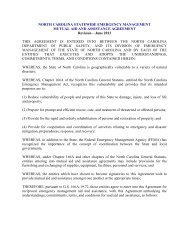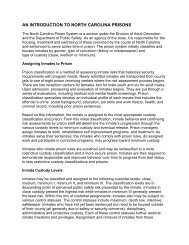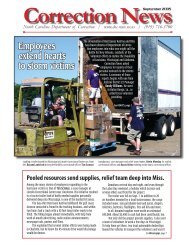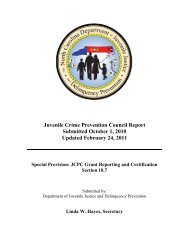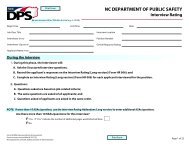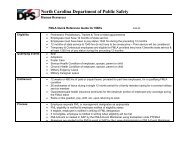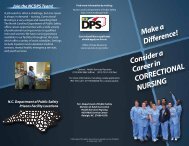September - North Carolina Department of Public Safety
September - North Carolina Department of Public Safety
September - North Carolina Department of Public Safety
Create successful ePaper yourself
Turn your PDF publications into a flip-book with our unique Google optimized e-Paper software.
6 | On the Scene | <strong>September</strong> 2012<br />
Below, Troop C Telecommunicator<br />
Morrissa Walters<br />
takes one <strong>of</strong> approximately<br />
1,100 calls received daily at<br />
the communications center.<br />
The busiest times are 5:30-9<br />
a.m., 11 a.m.-2 p.m. and<br />
4-6:30 p.m. during the week<br />
and early Sunday afternoon,<br />
right after most worship<br />
services conclude.<br />
Communicators<br />
from page 4<br />
life and death situation requesting immediate<br />
assistance?” he said. “From<br />
the public’s perception, help is simply<br />
around the corner. However, in reality,<br />
a trooper’s nearest help is <strong>of</strong>ten 15 to 20<br />
minutes away.<br />
The ability to provide critical descriptive<br />
information is a lifeline to<br />
troopers’ safety and well-being.<br />
“This is why telecommunicators are<br />
the most important asset the patrol has,”<br />
Gordon said.<br />
In addition to gathering and providing<br />
accurate information, telecommunicators<br />
also have multiple means <strong>of</strong><br />
contacting troopers — walkie-talkies,<br />
VIPER radios and cell phones. They<br />
also have access to cameras that constantly<br />
watch key stretches <strong>of</strong> highway.<br />
Winstead foresees the day when a<br />
telecommunicator will be able to track<br />
a patrol car on a computer display and<br />
know instantly which trooper is nearest<br />
to the scene <strong>of</strong> a call.<br />
Telecommunicators are highly<br />
trained. The job requires 200 hours <strong>of</strong><br />
in-house training, four weeks <strong>of</strong> Telecommunicator<br />
School and one week <strong>of</strong><br />
training on the use <strong>of</strong> the Division <strong>of</strong><br />
Criminal Information database.<br />
Although the work <strong>of</strong> Highway Patrol<br />
telecommunicators is serious business,<br />
a call will sometimes present a<br />
light moment.<br />
“We get all kinds <strong>of</strong> calls,” Winstead<br />
said. “If you can imagine it, we’ve gotten<br />
the call over the years.”<br />
He said a man called one evening<br />
from near Rolesville, in northern Wake<br />
County. “The man said, ‘Sir, I’m not<br />
Above, a trooper converses with his troop’s<br />
communications center.<br />
drunk, and I’ve not been drinking a<br />
drop. But I just saw a black panther run<br />
across the road!’”<br />
Winstead was amused that the caller<br />
was worried that Winstead wouldn’t<br />
believe him. He said bear sightings are<br />
not uncommon in Wake County, but the<br />
panther report gave him pause.<br />
“I decided that I had ought to follow<br />
up on it, and called the [<strong>North</strong> <strong>Carolina</strong><br />
Wildlife Resources] folks,” Winstead<br />
said. “And sure enough, they said they<br />
had heard about similar other panther<br />
sightings.”<br />
All calls to the communications<br />
centers are important; in reality, some<br />
are much more important than others.<br />
Both deserve a response, but a report <strong>of</strong><br />
a wreck with personal injuries is more<br />
critical than a request for help for a vehicle<br />
with a blown engine.<br />
The Highway Patrol coordinates with<br />
the <strong>North</strong> <strong>Carolina</strong> <strong>Department</strong> <strong>of</strong> Transportation<br />
in responding to less critical<br />
calls, such as road hazards and disabled<br />
vehicles.<br />
DOT’s Ben Griffin said the Incident<br />
Management Assistant Program started<br />
out providing motorist assistance, which<br />
included fueling vehicles, changing<br />
tires and performing simple repairs. It<br />
evolved to include emergency traffic<br />
control on interstate highways and then<br />
to helping the Highway Patrol quickly<br />
clear the roadway <strong>of</strong> crashed vehicles<br />
and debris.<br />
Griffin, Division 5 incident management<br />
engineer, said DOT’s traffic management<br />
centers allow quick and efficient<br />
sharing <strong>of</strong> information gathered by<br />
operators who monitor cameras around<br />
See Communicators, page 13



